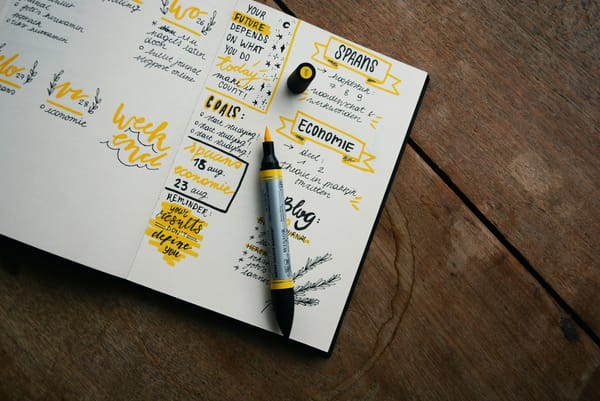How to Find Balance: Three Books That Will Teach You to Live Stoically
Discover how to live stoically with three insightful books that teach you to embrace challenges and cultivate inner peace. Start your journey today!

Stoicism has helped me overcome several difficult situations that used to cause me anxiety and worry in the past. First and foremost, the philosophy of Stoicism taught me to accept what I cannot control. There are many situations in life when circumstances are not in your favor: illnesses, failures, disagreements with loved ones. I used to perceive these as personal defeats, internally agonizing and losing my peace of mind. But Stoicism gave me tools to look at such things differently.
Stoicism has also helped me deal with rejections and failures. Previously, each rejection was perceived as something personal, as an indicator of my inadequacy. But Stoics teach that our self-esteem should not depend on external factors - be it the opinions of others or external circumstances. Now I see every failure as an opportunity for growth and learning, not a reason for self-criticism. This radically changed my attitude towards difficulties: I began to perceive them as temporary obstacles that help me become stronger and wiser.
Stoicism has made me calmer, more disciplined, and more mindful. It gave me the strength to accept life as it is and find opportunities for self-improvement in each day.
I've tried writing about Stoicism before. It's a philosophy I try to follow. But for now, I think the books I'm going to talk about next will explain it better.
I've chosen three books that examine Stoicism at different levels of understanding. Some of them are suitable for teenagers to read, others are for more advanced readers. I selected them based on the principle of reader evolution: if you read them in sequence, you can transform into a person ready for Stoicism.
Essentialism: The Disciplined Pursuit of Less
Let's start with "Essentialism: The Path to Simplicity" — this is the easiest approach to Stoicism. Essentialism is a way of acting that teaches you to do less, but better. This book is for those who are always busy, have a ton of things to do, and constantly experience mental anxiety. Oh, a lot on your plate? This book is for you, it's your best bet.
Main ideas
Essentialism is a philosophy of minimalism that teaches you to focus on one important thing and let go of everything unnecessary. The book argues that in a world where we are constantly distracted, it's important to maintain priorities. The main thesis is that our attention should be focused on one priority, rather than scattered across multiple tasks.
Why you should read it
If you constantly feel overwhelmed by numerous tasks and responsibilities, this book will be an excellent guide. It helps you understand how to better organize your life by freeing it from unnecessary things and focusing on what's essential. The book is written in simple language, making it accessible even for teenagers.
What this book will teach you
Essentialism will teach you how to properly prioritize and say "no" to unnecessary commitments. It's an approach that will help reduce stress levels and increase productivity. You'll understand that fewer tasks, but deeper execution of them, is the key to success.
What I noted
This book stuck with me because of one phrase, one fact. It was comprehensive for me, and perhaps it will help you too.
In the 15th century, the word "priority" entered the English language. And only in the 20th century did this word acquire a plural form. That is, until the 20th century, there was only one priority, and all these multiple entities appeared quite recently. This, in short, is the essence of the book. Throughout the narrative, the author tells us: there is only one thing, only one task that we can do. This is how our brain works, this is how our entire organism functions, and it is tuned precisely to this. It helps us act accordingly.
This principle is vividly illustrated by the example of Steve Jobs. When he returned to Apple in 1997, the company was on the brink of bankruptcy and was producing too many different products. Jobs made a radical decision — to reduce the product line and focus only on a few key areas that could lead the company to success. This was a classic example of essentialism: rejecting numerous insignificant tasks and fully concentrating on the most important ones. As a result of this approach, Apple was able to develop revolutionary products such as the iMac and iPhone, which made it one of the most successful companies in the world.
Returning to the description of the book, it's worth noting that it's written in language accessible to teenagers. However, it has quite long chapters and sections that teenagers sometimes find difficult to tackle due to laziness or difficulty in comprehension.
It can be classified as popular psychology and self-help books, with little "fluff" and everything to the point.
Oddly enough, this book can be called a "magic pill". It contains answers to many questions and secrets of success. For people looking for simple solutions, this book is exactly what you need.
Conclusion
"Essentialism" helps focus on the main things and eliminate the unnecessary, which is an important step on the path to a Stoic worldview. The next book, "Stillness is the Key", deepens these ideas, adding philosophical aspects and personal experience, which will help you better understand the path to inner peace and resilience.
Stillness Is the Key
The second book is a bit more complex - we're increasing the difficulty. "Stillness is the Key" by Ryan Holiday still falls under popular psychology, but it already touches on Stoicism. It was written by a person who has been practicing this teaching for 10 years, and it shows. The book is subjective, but in this case, that's a plus.
Main ideas
Ryan Holiday views calmness as a state of mind that allows for making more balanced decisions and maintaining equilibrium in any life situation. The book consists of 34 short chapters, each offering a unique perspective on how to achieve calmness.
Why you should read it
This book will appeal to those looking for a practical guide to managing stress and achieving inner harmony. Holiday shares his personal stories and explains how the principles of Stoicism can help attain peace of mind. The short chapters make it convenient for daily reading - you can read one chapter a day and reflect on it.
What this book will teach you
The book teaches how to maintain calmness even in the most stressful situations. You'll learn about the importance of rest, self-control, and proper time management. The example with Churchill shows that even the busiest people can find time for recovery.
What I noted
It doesn't just tell, but shows how to live practicing Stoicism. It's not exactly a Stoic's diary, but the author constantly shares his experience. The book consists of 34 short chapters about calmness. In short: there is calmness as a state, and the author approaches it from different angles 34 times.
The chapters are short and diverse: they include personal experiences, references to Marcus Aurelius, historical facts, and scientific data. It's a kind of daily mantra. The great thing is that you can read one chapter a day. There's no rush - you read a chapter and think about it all day. Or you read in the evening and ponder it the next day or before sleep.
The main goal of the book, as I see it, is to find balance between body, soul, and mind, or at least to stop the "crossfire" between these parts of our personality. All chapters are collected in three sections and help conduct an internal restructuring.
What stuck with me the most was the story about Churchill and rest. It teaches that rest is not inactivity, but a change of activity. Churchill had a hobby: he painted. Not professionally, without artistic ambitions - he was simply calmed by how the brush glided across the canvas. He always found time to paint, even during World War II, when time was obviously scarcer.
I was struck not so much by the story itself, but by the author's words: if Churchill found time, then you, busy person, will find time for sports or a hobby. If you're lazy, don't justify yourself with busyness. This thought pierced me - it exposed my excuses.
A typical example of applying this thought is an office worker who, feeling tired from constant tasks and deadlines, dedicates 30 minutes every evening to walking in the park, running, or engaging in hobbies such as reading books or building models. These small but regular switches help him avoid overload and burnout, maintaining a balance between work and personal life.
Conclusion
Ryan Holiday's "Stillness is the Key" adds philosophical aspects to the simple ideas of essentialism. This book will help you not only better organize your life but also find inner balance based on the principles of Stoicism. After you master this book, you'll be ready to delve into deeper reflections on Stoicism offered by Massimo Pigliucci in "How to Be a Stoic".
How to Be a Stoic
The third book - "How to Be a Stoic" by Massimo Pigliucci - connects ancient philosophy with modern life. It's a more challenging read, as the author is a professor of philosophy and evolutionary biology. The book presents reflections of a modern philosopher on ancient philosophy.
Main ideas
Massimo Pigliucci takes the principles of ancient Stoicism and analyzes them from the perspective of modern life. He shows how the philosophical reflections of ancient Stoics can help us make sense of questions about life and death, as well as ethical dilemmas.
Why you should read it
This book is suitable for those who want to delve deeper into the philosophy of Stoicism. Unlike lighter books on popular psychology, "How to Be a Stoic" offers a more profound analysis of Stoic principles and their relevance to modern life.
What this book will teach you
Reading this book will teach you to think like a Stoic. It will help you understand the philosophy of Stoicism more deeply, and will also examine its influence on topics such as accepting death, realizing the limitations of time, and developing moral principles that can improve your life.
What I noted
Compared to "The Power of Calm," which describes the lifestyle of a Stoic, Pigliucci demonstrates how to think Stoically. He takes a thesis from Stoicism and carefully analyzes it. At times, this can seem tedious or incomprehensible, especially when he refers to lesser-known philosophers. However, when the author expands a quote into an entire chapter, it becomes fascinating. The book teaches you to think like a Stoic.
Reading this book requires effort - I read it slowly and sometimes skipped parts. But it contains very valuable insights absent from the previous books. For example, the history of Stoicism. The author examines Stoicism as a philosophical movement, provides a "roadmap" of its origins, and talks about prominent Stoics. He touches on their attitudes towards death and God - topics that authors of previous books avoided. A philosopher can afford this, because without contemplating death, it's impossible to truly study Stoicism. This is one of the key principles - to remember death every day. And Pigliucci explains this in accessible language.
Conclusion
"How to Be a Stoic" is already a more complex read compared to the previous books. After you master the basics through "Essentialism" and the practical advice of "The Power of Calm," this book will offer you a deeper dive into philosophical reflections on life and death, which are an important part of Stoicism.
Your "Hero's Journey"
Reading all three books provides an excellent knowledge base. After that, you can move on to primary sources and form your own understanding of Stoicism, learning to rethink what you've read in new ways.
"Essentialism" is an excellent example of popular psychology.
"The Power of Calm" contains useful ideas for both children and adults. It's sure to touch on at least one sensitive topic for any adult reader. However, there's a sense of a catch here, a kind of manipulation by the author. Not surprising, considering he has written books about manipulation.
"How to Be a Stoic" is a book that makes you feel smarter. It's about philosophy, but presented more accessibly than classical philosophical works. Philosophy may seem like something for the experienced, but in reality, it asks questions that everyone should ponder.
Now that Stoicism is at the peak of its popularity, perhaps we should approach it more simply? Don't be afraid to read these texts, ask yourself questions, discuss our attitude towards death or ethical dilemmas over lunch, quote and analyze citations. It's interesting and has nothing to do with snobbery.
Concluding Thoughts
Stoicism is experiencing a true renaissance today, and it's not surprising. In our rapidly changing world, full of stress and uncertainty, a teaching that helps maintain calm, focus, and clarity of mind is more relevant than ever. However, the key point is that Stoicism is not just a philosophy, but a practical guide to action.
If the ideas from these books have inspired you, I suggest starting small: choose one Stoic practice and apply it for a week. For example, the "dichotomy of control" - a principle that teaches to focus only on what's in your power and let go of everything else. When faced with an unexpected situation at work, don't worry about what you can't change, but focus on what's truly in your hands.
Or try to reflect daily on what's truly important to you, as essentialism teaches, and direct your time and energy only to these things. You'll see how even such simple actions can radically change your attitude towards life and help you find more inner peace.
Starting with these small steps, you'll gradually feel how Stoicism becomes an integral part of your daily life, helping you cope with difficulties and find harmony even in the most challenging situations.
As always, I invite you to share your opinion in the comments
With love 😽 🤗 😘
K




